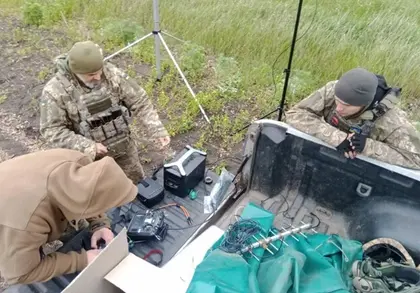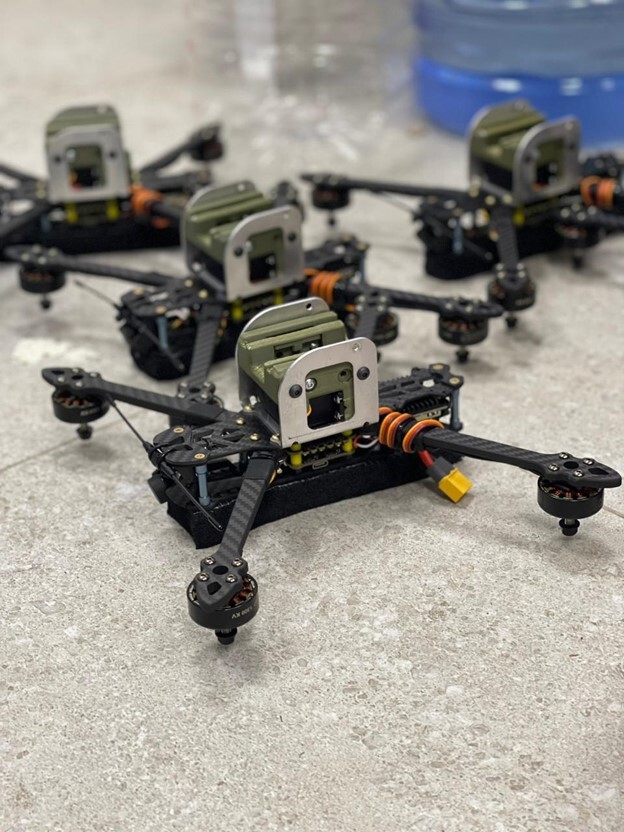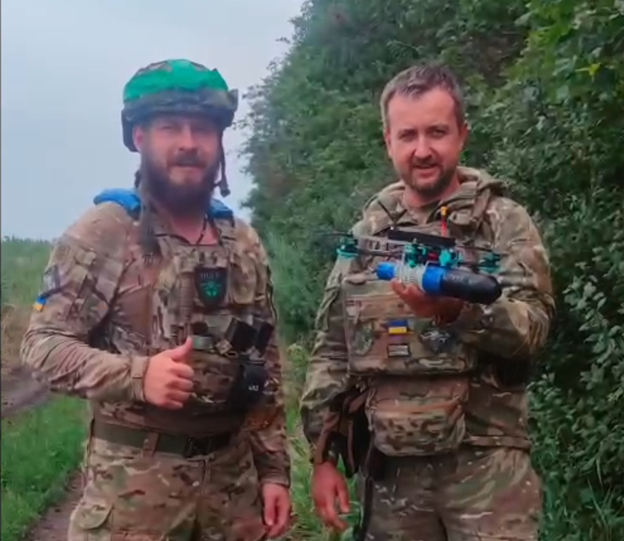Mykhailo’s squad has a seemingly impossible task ahead. Stationed in southern Ukraine as part of Ukraine’s counteroffensive, they must find a way to clear out a network of Russian trenches manned by a well-dug-in enemy that has both more troops and more armored equipment.
But what the Russians don’t have is Wild Hornets. The quick, highly maneuverable drones, hand-assembled by Ukrainian volunteers, are uniquely able to serve in a kamikaze role as guided missiles, munition-dropping micro-bombers, or for aerial reconnaissance.
- Get the freshest Ukraine news updates as of today.
- Look at the most up-to-date Ukraine news that came out today.
JOIN US ON TELEGRAM
Follow our coverage of the war on the @Kyivpost_official.
Mykhailo’s unit sets its 10 Wild Hornets to bomb-dropping mode and goes to work. In a non-stop relay of destruction, his squad uses the drones to precisely target Russian trenches and armor, zip back to reload, then quickly return to rain down more damage.
Relentless storm
The relentless storm of pinpoint attacks and mounting losses forces the beleaguered enemy into a disorderly retreat. With the Wild Hornets and Ukrainian troops in hot pursuit, the Russians are obliged to keep ceding ground for the rest of the day. By nightfall, the Ukrainian unit has advanced three kilometers.
“It’s a very cost-effective and precise weapon,” Mykhailo says from a frontline position in a recording to answer questions. “We have less weaponry and less artillery than the enemy, so we have had to think of something to make up for this that costs a lot less than artillery munitions.

Zelensky Meets CIA Director William Burns in Ukraine
“The Wild Hornet fills that need,” he remarks.
Mykhailo’s unit is part of a quickly growing list of most famed and crack Ukrainian brigades and formations that are using Wild Hornets in the counteroffensive and other active sectors of the front. That includes Ukraine’s HUR military intelligence operators, the Separate Presidential Brigade, the 3rd Separate Assault Brigade, the 24th Separate Mechanized Brigade and the 120th Separate Reconnaissance Battalion.
Bargain cost, premium results
About the size of a kitten, each Wild Hornet can carry a 2-kilogram payload, such as an anti-tank rocket round. That’s four times more carrying capacity than the Mavic 3, the drone most commonly used by Ukrainian forces, which can only carry 500 grams (the weight of a hand grenade).
The Wild Hornet also costs a fraction of the price ($400 versus $2,000-$3,000 for a Mavic), flies five times faster (150 km/h versus 30 km/h) and can be customized to operate at a variety of ranges, payload capacities and signal frequencies, depending on a unit’s needs. A Mavic, by comparison, comes pre-assembled from the Chinese manufacturer and can’t be used in a kamikaze role.
Another key difference: Wild Hornets don’t use GPS, making them much harder for the enemy to track back to locate and target the operator. They can also operate at frequencies difficult for Russians to jam with electronic warfare systems.
Hot potential, high demand
The idea for the drone came from Dmytro Prodanyuk, a website developer and volunteer with the Kyiv-based volunteer charity Svoboda Ukrainy (Freedom of Ukraine).
Prodanyuk says a friend in Ukraine’s elite Separate Presidential Brigade asked him in February if the volunteers could supply first-person view (FPV) drones for use in a kamikaze role (i.e., as guided bombs). Super-speedy and maneuverable FPV drones, designed for drone races on winding courses, are piloted with hand controllers and a headset that shows a live video feed from the drone’s nose.
Prodanyuk didn’t have much prior knowledge of FPV drones, but he told his friend he’d look into them. He quickly saw the military potential and offered to design a kamikaze drone that could also drop bombs and do reconnaissance – a multi-role capability few drones possess.
“I realized right away I needed to put maximum effort in this,” he says in an interview while enroute to deliver 20 Wild Hornets to the front, along with a pickup truck bought with donations to Svoboda Ukrainy.
The brigade was immediately interested in such a multi-purpose FPV drone and sent drone operators to train on the new system. Prodanyuk dropped all his other volunteer work to focus on the new project along with four other volunteers, including several engineers.
They set about raising money to build an initial batch of drones. The outputs were an immediate hit with the troops, who sent Prodanyuk videos of Wild Hornets smashing into enemy tanks and other military equipment. “They were calling to thank us for allowing the drone operators to save soldiers’ lives, and they wanted us to send more,” he recalls.
Fundraising via Censor.net
Prodanyuk needed money to build more drones, which led him to ask for fundraising help from various media outlets, including Censor.net, the news site run by well-known Ukrainian military journalist and anti-corruption activist Yuri Butusov.
“At first we looked at this skeptically because we saw that Dmytro didn’t have a lot of experience making these kinds of drones,” Yuri Vynnychuk, business editor at Censor.net, explains in an interview. “But we confirmed his credibility and talked to soldiers who use the drones. We were impressed. Now we are helping systematically.”
The news site held a fundraiser in the spring for Hr. 1.7 million ($46,000) for over 100 Wild Hornets, and launched a second campaign in late June to raise another Hr. 1 million ($27,000). Over Hr. 400,000 ($11,000) was donated in less than a week.
With fundraising requests from many volunteer groups and a variety of potential drones to back, Vynnychuk says Censor.net decided to support Wild Hornets because of their multi-role functionality, low cost, customizability, resistance to jamming and signal geolocation, and superior performance.
Saving lives of Ukrainian soldiers
“This is ground-breaking new technology being developed by Ukrainians,” Vynnychuk points out. “The drones are fast, highly maneuverable and almost impossible for the enemy to shoot down. They’re saving the lives of Ukrainian soldiers. There’s a colossal return if you can destroy a $1 million or $2 million tank with a drone that costs $400.”
Offering another key advantage, Wild Hornets are made in Ukraine with easily obtained components, and they aren’t as vulnerable to procurement challenges as Mavics, which can be held up by border bottlenecks and the Chinese manufacturer’s attempts to restrict sales to Ukraine.
Ukraine’s defense ministry pledged Hr. 20 billion ($540 million) in January to buy drones, but many – if not most – drones used by Ukrainian troops are still bought with donations from Ukrainians and their supporters around the world.
A drone operator with Ukraine’s 1st Tank Brigade, fighting in Zaporizhzhia, told The Guardian in June that his unit’s members spend up to 70 percent of their pay to buy drones. Indeed, the need far outpaces the supply, with Ukrainian forces losing 300-500 drones a day in combat, mostly due to Russian electronic warfare (EW), Censor.net reported in May.
Surging demand from troops
As word spreads about the EW-resistant Wild Hornets, demand from the front is exploding, Prodanyuk says, and his five-volunteer team can’t keep up. They now supply five Ukrainian brigades and other units, working around the clock to hand-assemble 100 to 150 drones a month, with plans to increase production volume to up to 400 and launch more fundraisers.
“It’s a lot but it’s not a lot at the same time. We need thousands,” he says. “Our main problems are we need more funds and more people to make more drones.”
Prodanyuk’s team continually improves the drones based on feedback from frontline troops and is now developing new models that can carry a five-kilogram payload and operate at night.
“We’re constantly thinking of how to make them better and new ways to use them to defeat the enemy,” he reveals. “We convert every donation into destroyed invaders, which saves our people’s lives.”
Cheaper and more effective than mortars and artillery
Back at the front, Mykhailo eagerly awaits the arrival of more drones. Compared to mortars or artillery, he prefers Wild Hornets. “The accuracy of a mortar strike is limited and is highly affected by distance, weather conditions and wind,” he says, noting that a mortar round can cost $1,500 to $2,000.
“At a distance of five kilometers, it’s very hard for a mortar to hit a narrow trench line to target enemy personnel. With an FPV drone, we can guide the munition precisely to the target almost until the final second. It’s many times cheaper and more effective than a mortar. The comparison isn’t even close. I won’t even compare it to heavy artillery; the comparison there is even more in favor of FPV drones.
“And if we use the Wild Hornet to drop a munition, we can use it 10 or 15 times. This means the cost of a strike goes down even more by several times. And that’s why it’s a very good weapon.”
Donations for Wild Hornets can be sent to Ukrainian volunteer group Svoboda Ukrainy via PayPal to this email address: donate@svoboda-ukrainy.com
You can also highlight the text and press Ctrl + Enter














